Fengyun Rao
WAVE: Learning Unified & Versatile Audio-Visual Embeddings with Multimodal LLM
Sep 26, 2025



Abstract:While embeddings from multimodal large language models (LLMs) excel as general-purpose representations, their application to dynamic modalities like audio and video remains underexplored. We introduce WAVE (\textbf{u}nified \& \textbf{v}ersatile \textbf{a}udio-\textbf{v}isual \textbf{e}mbeddings), the first LLM-based embedding that creates a unified representation space for text, audio, and video modalities. WAVE employs a novel hierarchical feature fusion strategy and a joint multi-modal, multi-task training approach to enable two key capabilities: any-to-any cross-modal retrieval and the generation of prompt-aware embeddings tailored to user instructions. Experimentally, WAVE sets a new state-of-the-art on the MMEB-v2 video benchmark and achieves superior results in audio and video-to-audio retrieval. Its prompt-aware nature also yields remarkable performance in multimodal question answering, significantly outperforming existing embedding models. Ablation studies validate our joint training strategy, demonstrating improved performance across all modalities. With a newly introduced benchmark for versatile audio-visual learning, WAVE opens up broad possibilities for cross-modal, any-to-any applications. Our code, checkpoints, and data will be released.
HQ-CLIP: Leveraging Large Vision-Language Models to Create High-Quality Image-Text Datasets and CLIP Models
Jul 30, 2025Abstract:Large-scale but noisy image-text pair data have paved the way for the success of Contrastive Language-Image Pretraining (CLIP). As the foundation vision encoder, CLIP in turn serves as the cornerstone for most large vision-language models (LVLMs). This interdependence naturally raises an interesting question: Can we reciprocally leverage LVLMs to enhance the quality of image-text pair data, thereby opening the possibility of a self-reinforcing cycle for continuous improvement? In this work, we take a significant step toward this vision by introducing an LVLM-driven data refinement pipeline. Our framework leverages LVLMs to process images and their raw alt-text, generating four complementary textual formulas: long positive descriptions, long negative descriptions, short positive tags, and short negative tags. Applying this pipeline to the curated DFN-Large dataset yields VLM-150M, a refined dataset enriched with multi-grained annotations. Based on this dataset, we further propose a training paradigm that extends conventional contrastive learning by incorporating negative descriptions and short tags as additional supervised signals. The resulting model, namely HQ-CLIP, demonstrates remarkable improvements across diverse benchmarks. Within a comparable training data scale, our approach achieves state-of-the-art performance in zero-shot classification, cross-modal retrieval, and fine-grained visual understanding tasks. In retrieval benchmarks, HQ-CLIP even surpasses standard CLIP models trained on the DFN-2B dataset, which contains 10$\times$ more training data than ours. All code, data, and models are available at https://zxwei.site/hqclip.
WeThink: Toward General-purpose Vision-Language Reasoning via Reinforcement Learning
Jun 09, 2025Abstract:Building on the success of text-based reasoning models like DeepSeek-R1, extending these capabilities to multimodal reasoning holds great promise. While recent works have attempted to adapt DeepSeek-R1-style reinforcement learning (RL) training paradigms to multimodal large language models (MLLM), focusing on domain-specific tasks like math and visual perception, a critical question remains: How can we achieve the general-purpose visual-language reasoning through RL? To address this challenge, we make three key efforts: (1) A novel Scalable Multimodal QA Synthesis pipeline that autonomously generates context-aware, reasoning-centric question-answer (QA) pairs directly from the given images. (2) The open-source WeThink dataset containing over 120K multimodal QA pairs with annotated reasoning paths, curated from 18 diverse dataset sources and covering various question domains. (3) A comprehensive exploration of RL on our dataset, incorporating a hybrid reward mechanism that combines rule-based verification with model-based assessment to optimize RL training efficiency across various task domains. Across 14 diverse MLLM benchmarks, we demonstrate that our WeThink dataset significantly enhances performance, from mathematical reasoning to diverse general multimodal tasks. Moreover, we show that our automated data pipeline can continuously increase data diversity to further improve model performance.
Instruction-augmented Multimodal Alignment for Image-Text and Element Matching
Apr 16, 2025Abstract:With the rapid advancement of text-to-image (T2I) generation models, assessing the semantic alignment between generated images and text descriptions has become a significant research challenge. Current methods, including those based on Visual Question Answering (VQA), still struggle with fine-grained assessments and precise quantification of image-text alignment. This paper presents an improved evaluation method named Instruction-augmented Multimodal Alignment for Image-Text and Element Matching (iMatch), which evaluates image-text semantic alignment by fine-tuning multimodal large language models. We introduce four innovative augmentation strategies: First, the QAlign strategy creates a precise probabilistic mapping to convert discrete scores from multimodal large language models into continuous matching scores. Second, a validation set augmentation strategy uses pseudo-labels from model predictions to expand training data, boosting the model's generalization performance. Third, an element augmentation strategy integrates element category labels to refine the model's understanding of image-text matching. Fourth, an image augmentation strategy employs techniques like random lighting to increase the model's robustness. Additionally, we propose prompt type augmentation and score perturbation strategies to further enhance the accuracy of element assessments. Our experimental results show that the iMatch method significantly surpasses existing methods, confirming its effectiveness and practical value. Furthermore, our iMatch won first place in the CVPR NTIRE 2025 Text to Image Generation Model Quality Assessment - Track 1 Image-Text Alignment.
From Trial to Triumph: Advancing Long Video Understanding via Visual Context Sample Scaling and Self-reward Alignment
Mar 26, 2025Abstract:Multi-modal Large language models (MLLMs) show remarkable ability in video understanding. Nevertheless, understanding long videos remains challenging as the models can only process a finite number of frames in a single inference, potentially omitting crucial visual information. To address the challenge, we propose generating multiple predictions through visual context sampling, followed by a scoring mechanism to select the final prediction. Specifically, we devise a bin-wise sampling strategy that enables MLLMs to generate diverse answers based on various combinations of keyframes, thereby enriching the visual context. To determine the final prediction from the sampled answers, we employ a self-reward by linearly combining three scores: (1) a frequency score indicating the prevalence of each option, (2) a marginal confidence score reflecting the inter-intra sample certainty of MLLM predictions, and (3) a reasoning score for different question types, including clue-guided answering for global questions and temporal self-refocusing for local questions. The frequency score ensures robustness through majority correctness, the confidence-aligned score reflects prediction certainty, and the typed-reasoning score addresses cases with sparse key visual information using tailored strategies. Experiments show that this approach covers the correct answer for a high percentage of long video questions, on seven datasets show that our method improves the performance of three MLLMs.
Instruction-Oriented Preference Alignment for Enhancing Multi-Modal Comprehension Capability of MLLMs
Mar 26, 2025
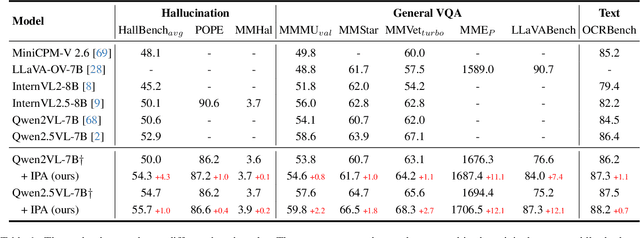
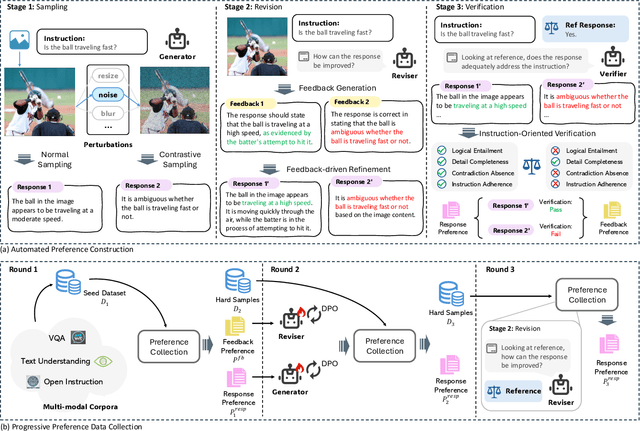

Abstract:Preference alignment has emerged as an effective strategy to enhance the performance of Multimodal Large Language Models (MLLMs) following supervised fine-tuning. While existing preference alignment methods predominantly target hallucination factors, they overlook the factors essential for multi-modal comprehension capabilities, often narrowing their improvements on hallucination mitigation. To bridge this gap, we propose Instruction-oriented Preference Alignment (IPA), a scalable framework designed to automatically construct alignment preferences grounded in instruction fulfillment efficacy. Our method involves an automated preference construction coupled with a dedicated verification process that identifies instruction-oriented factors, avoiding significant variability in response representations. Additionally, IPA incorporates a progressive preference collection pipeline, further recalling challenging samples through model self-evolution and reference-guided refinement. Experiments conducted on Qwen2VL-7B demonstrate IPA's effectiveness across multiple benchmarks, including hallucination evaluation, visual question answering, and text understanding tasks, highlighting its capability to enhance general comprehension.
R1-Onevision: Advancing Generalized Multimodal Reasoning through Cross-Modal Formalization
Mar 13, 2025Abstract:Large Language Models have demonstrated remarkable reasoning capability in complex textual tasks. However, multimodal reasoning, which requires integrating visual and textual information, remains a significant challenge. Existing visual-language models often struggle to effectively analyze and reason visual content, resulting in suboptimal performance on complex reasoning tasks. Moreover, the absence of comprehensive benchmarks hinders the accurate assessment of multimodal reasoning capabilities. In this paper, we introduce R1-Onevision, a multimodal reasoning model designed to bridge the gap between visual perception and deep reasoning. To achieve this, we propose a cross-modal reasoning pipeline that transforms images into formal textural representations, enabling precise language-based reasoning. Leveraging this pipeline, we construct the R1-Onevision dataset which provides detailed, step-by-step multimodal reasoning annotations across diverse domains. We further develop the R1-Onevision model through supervised fine-tuning and reinforcement learning to cultivate advanced reasoning and robust generalization abilities. To comprehensively evaluate multimodal reasoning performance across different grades, we introduce R1-Onevision-Bench, a benchmark aligned with human educational stages, covering exams from junior high school to university and beyond. Experimental results show that R1-Onevision achieves state-of-the-art performance, outperforming models such as GPT-4o and Qwen2.5-VL on multiple challenging multimodal reasoning benchmarks.
PerturboLLaVA: Reducing Multimodal Hallucinations with Perturbative Visual Training
Mar 09, 2025Abstract:This paper aims to address the challenge of hallucinations in Multimodal Large Language Models (MLLMs) particularly for dense image captioning tasks. To tackle the challenge, we identify the current lack of a metric that finely measures the caption quality in concept level. We hereby introduce HalFscore, a novel metric built upon the language graph and is designed to evaluate both the accuracy and completeness of dense captions at a granular level. Additionally, we identify the root cause of hallucination as the model's over-reliance on its language prior. To address this, we propose PerturboLLaVA, which reduces the model's reliance on the language prior by incorporating adversarially perturbed text during training. This method enhances the model's focus on visual inputs, effectively reducing hallucinations and producing accurate, image-grounded descriptions without incurring additional computational overhead. PerturboLLaVA significantly improves the fidelity of generated captions, outperforming existing approaches in handling multimodal hallucinations and achieving improved performance across general multimodal benchmarks.
HarmonySet: A Comprehensive Dataset for Understanding Video-Music Semantic Alignment and Temporal Synchronization
Mar 04, 2025


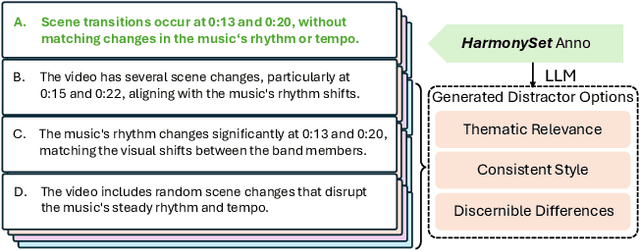
Abstract:This paper introduces HarmonySet, a comprehensive dataset designed to advance video-music understanding. HarmonySet consists of 48,328 diverse video-music pairs, annotated with detailed information on rhythmic synchronization, emotional alignment, thematic coherence, and cultural relevance. We propose a multi-step human-machine collaborative framework for efficient annotation, combining human insights with machine-generated descriptions to identify key transitions and assess alignment across multiple dimensions. Additionally, we introduce a novel evaluation framework with tasks and metrics to assess the multi-dimensional alignment of video and music, including rhythm, emotion, theme, and cultural context. Our extensive experiments demonstrate that HarmonySet, along with the proposed evaluation framework, significantly improves the ability of multimodal models to capture and analyze the intricate relationships between video and music.
Number it: Temporal Grounding Videos like Flipping Manga
Nov 15, 2024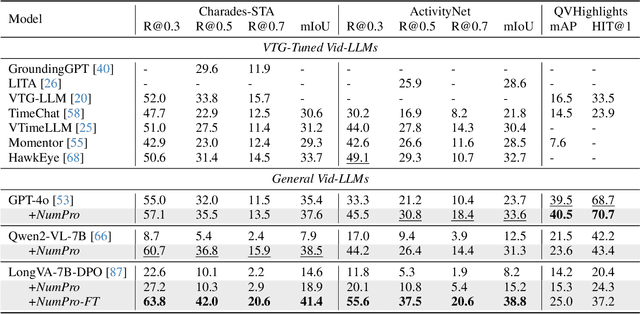
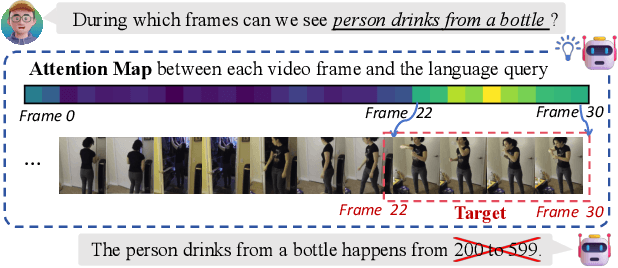

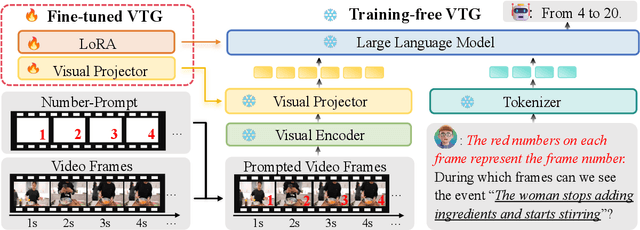
Abstract:Video Large Language Models (Vid-LLMs) have made remarkable advancements in comprehending video content for QA dialogue. However, they struggle to extend this visual understanding to tasks requiring precise temporal localization, known as Video Temporal Grounding (VTG). To address this gap, we introduce Number-Prompt (NumPro), a novel method that empowers Vid-LLMs to bridge visual comprehension with temporal grounding by adding unique numerical identifiers to each video frame. Treating a video as a sequence of numbered frame images, NumPro transforms VTG into an intuitive process: flipping through manga panels in sequence. This allows Vid-LLMs to "read" event timelines, accurately linking visual content with corresponding temporal information. Our experiments demonstrate that NumPro significantly boosts VTG performance of top-tier Vid-LLMs without additional computational cost. Furthermore, fine-tuning on a NumPro-enhanced dataset defines a new state-of-the-art for VTG, surpassing previous top-performing methods by up to 6.9\% in mIoU for moment retrieval and 8.5\% in mAP for highlight detection. The code will be available at https://github.com/yongliang-wu/NumPro.
 Add to Chrome
Add to Chrome Add to Firefox
Add to Firefox Add to Edge
Add to Edge